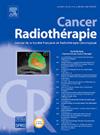单一高剂量率间质近距离治疗早期舌癌:一项系统综述
IF 1.4
4区 医学
Q4 ONCOLOGY
引用次数: 0
摘要
目的近距离放射治疗具有保留器官和功能的优点,是舌癌患者非常感兴趣的治疗方法。高剂量率近距离放射治疗是一种较新的近距离放射治疗形式,其优点是比流行的低剂量率近距离放射治疗具有更高的剂量一致性。本文旨在对早期舌癌单次高剂量近距离放射治疗的文献进行综述,探讨其治疗特点、治疗效果、毒副作用,并对其治疗效果进行重新评价。材料与方法利用PubMed搜索引擎在Medline数据库中进行系统综述。搜索的关键词包括间质性、近距离治疗和舌癌。纳入的文章必须研究使用独家高剂量率近距离放射治疗早期舌癌的结果。结果入选文章6篇,共305例患者。中位随访时间为21至53.5个月。最常用的技术是将60戈瑞的剂量分十次(每天两次),持续一周或五天。晚期效应和毒性最小;软组织和下颌骨坏死37例(12%)。当地5年和3年防治率分别为65% ~ 100%和71% ~ 94.7%。病因特异性和总生存率分别为57%至94%和46%至89.4%。结论单纯间质性高剂量率近距离放疗是治疗早期舌癌安全有效的方法。其主要优点是局部控制率高,器官功能保存较好。单纯间质性高剂量率近距离放射治疗是早期舌癌的一种可行的治疗选择。本文章由计算机程序翻译,如有差异,请以英文原文为准。
Sole high dose-rate interstitial brachytherapy for early-stage tongue cancer: A systematic review
Purpose
Brachytherapy has the advantage of preserving organs and function, which is of great interest to tongue cancer patients. High dose-rate brachytherapy is a newer form of brachytherapy with the advantage of higher dose conformity than the popular low dose-rate brachytherapy. This article aims to summarize the literature on sole high dose-rate brachytherapy for early-stage tongue cancer, its treatment characteristics, its treatment outcomes, toxicity and reassess its therapeutic benefits.
Materiel and methods
A systematic review was done in Medline database using the search engine PubMed. Keywords for the search included interstitial, brachytherapy and tongue cancer. Articles included had to study the outcome of the use of exclusive high dose-rate brachytherapy for early-stage tongue cancer.
Results
Eleven articles were eligible comprising 305 patients. The median follow-up ranged from 21 to 53.5 months. The most frequently utilized technique delivered a dose of 60 Gy in ten fractions (two daily fractions) for one week or five days. Late effects and toxicity were minimal; soft tissue and mandibular bone necrosis occurred in 37 patients (12 %). Local control rates at five years and three years ranged from 65 to 100 % and 71 to 94.7 %, respectively. Cause-specific and overall survival ranged from 57 to 94 % and 46 to 89.4 %, respectively.
Conclusion
Sole interstitial high dose-rate brachytherapy is a safe and efficient treatment option for early tongue cancer. The main advantage found is its high local control rate resulting to superior organ function preservation. Sole interstitial high dose-rate brachytherapy is a viable treatment option for early-stage tongue cancer.
求助全文
通过发布文献求助,成功后即可免费获取论文全文。
去求助
来源期刊

Cancer Radiotherapie
医学-核医学
CiteScore
2.20
自引率
23.10%
发文量
129
审稿时长
63 days
期刊介绍:
Cancer/radiothérapie se veut d''abord et avant tout un organe francophone de publication des travaux de recherche en radiothérapie. La revue a pour objectif de diffuser les informations majeures sur les travaux de recherche en cancérologie et tout ce qui touche de près ou de loin au traitement du cancer par les radiations : technologie, radiophysique, radiobiologie et radiothérapie clinique.
 求助内容:
求助内容: 应助结果提醒方式:
应助结果提醒方式:


